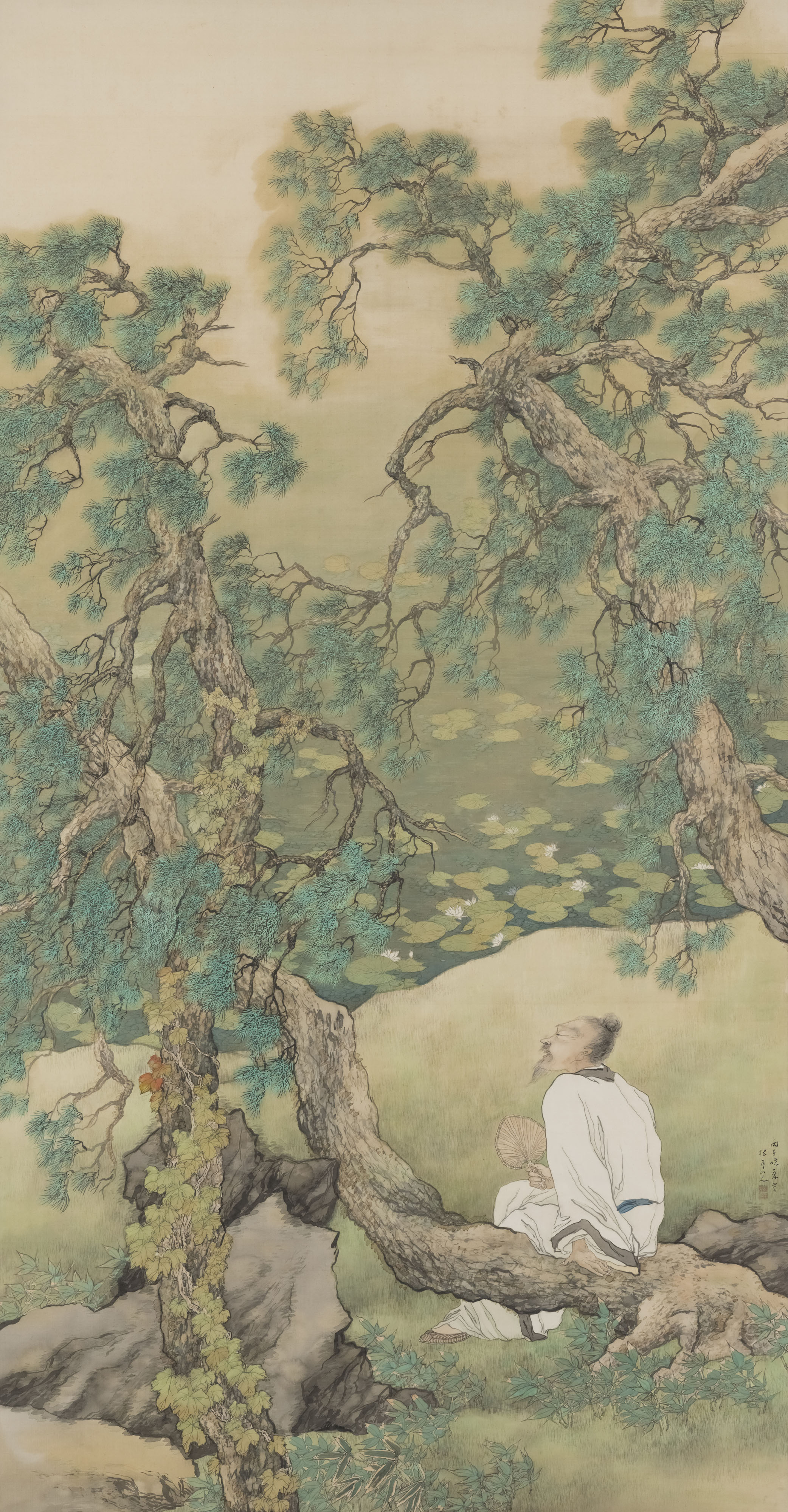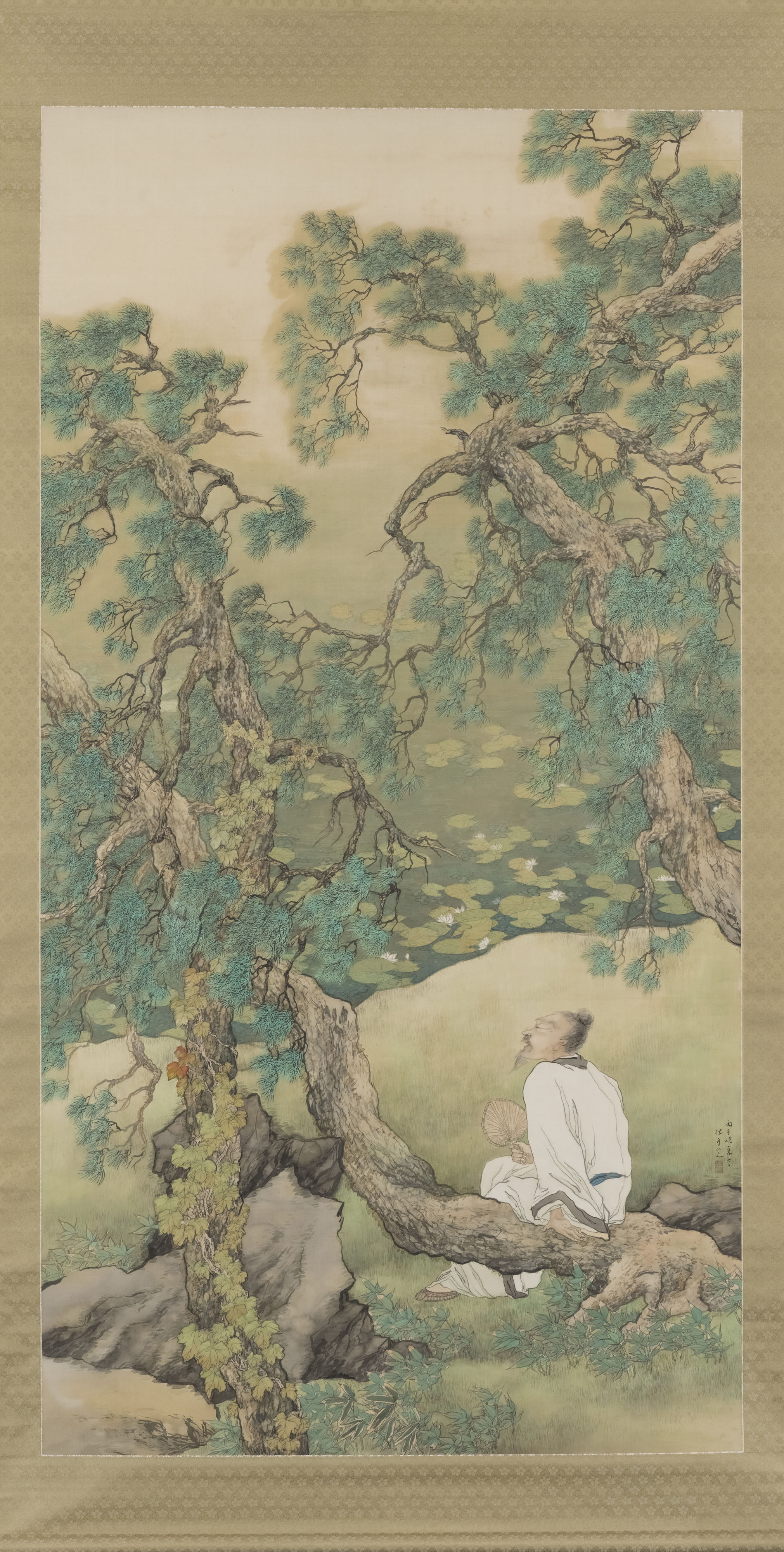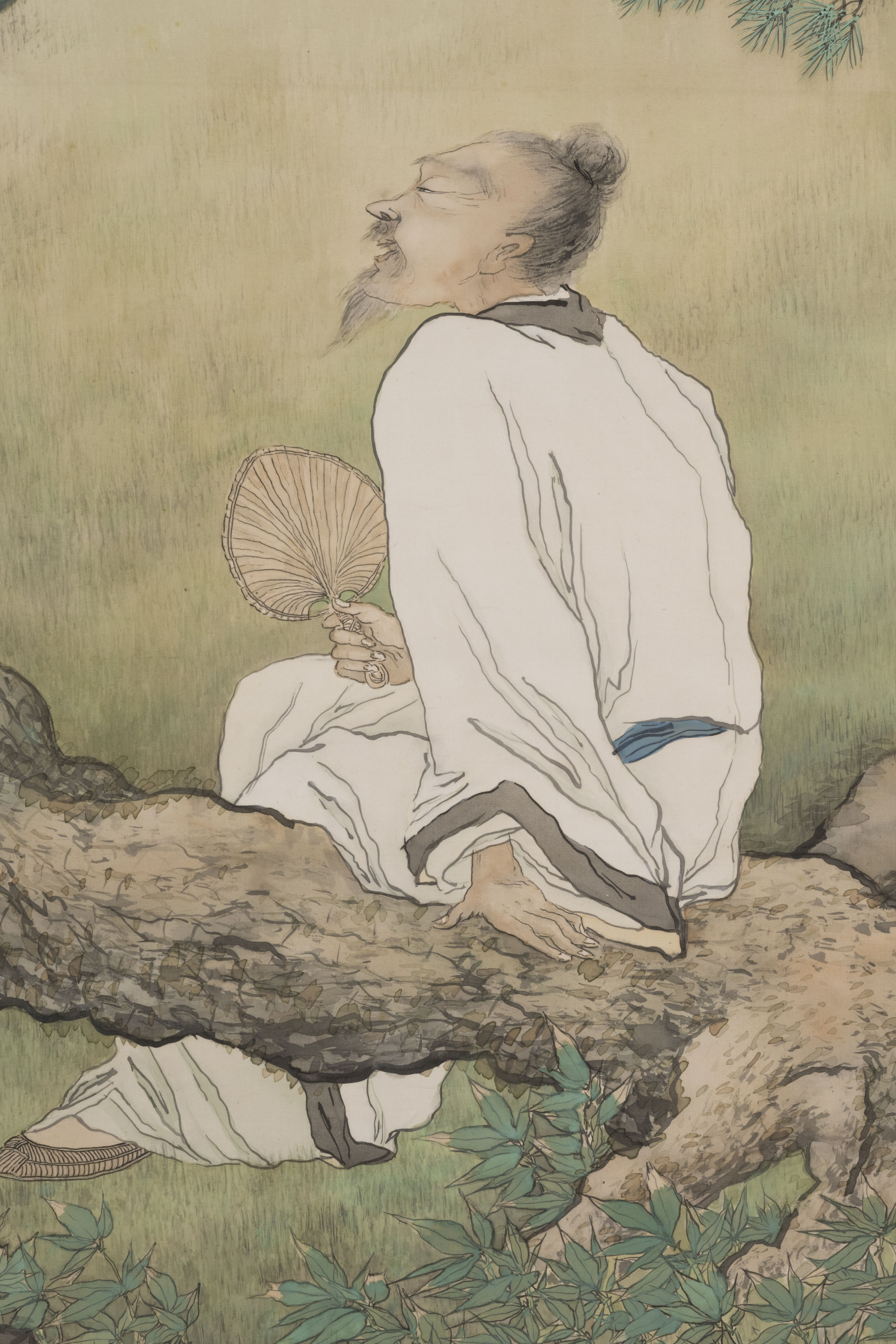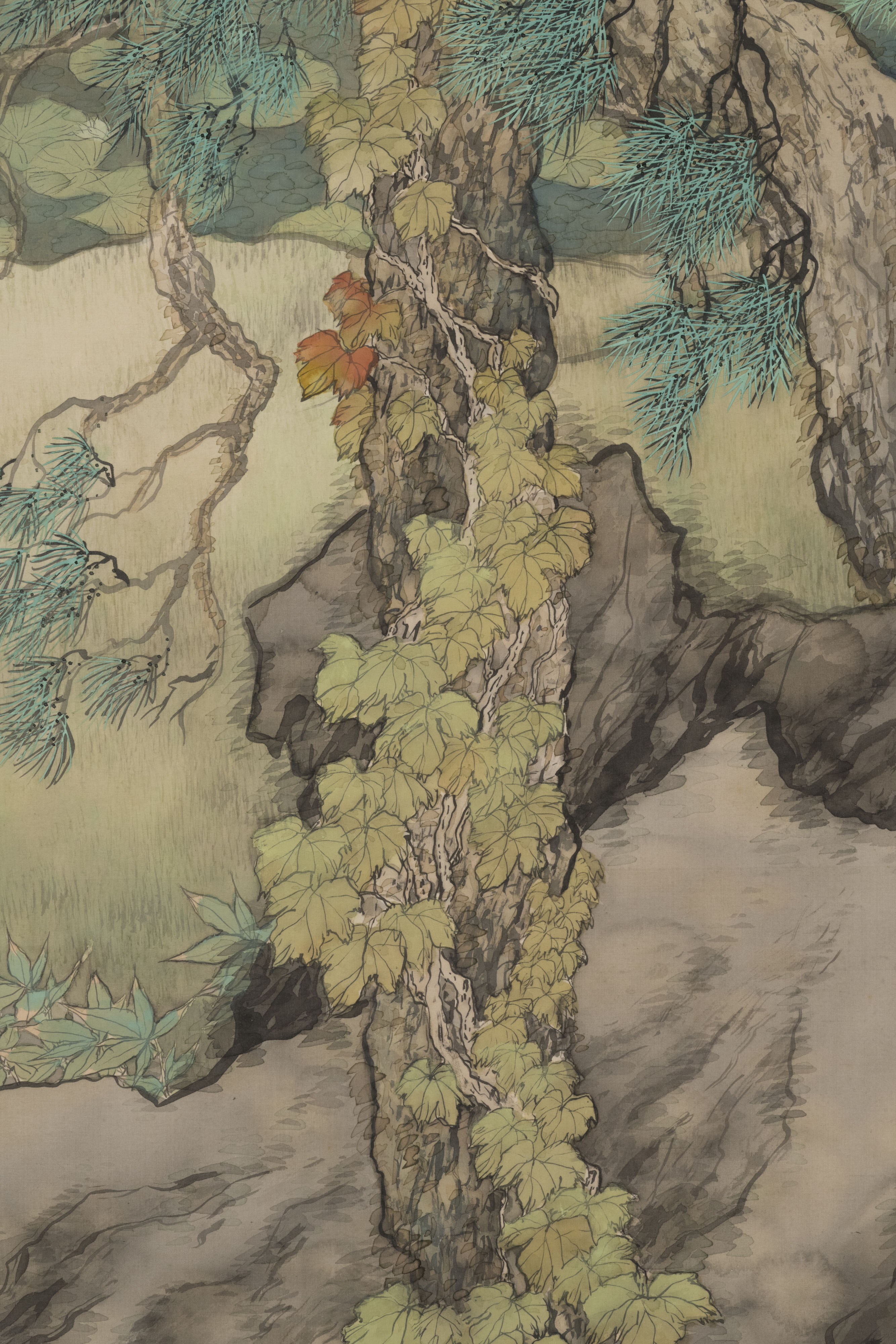
あいごろ 作品名6_28
1936(昭和11年)
絹本着色
「愛吾廬(我が廬【いおり】を愛す)という作品名は、中国の詩人・陶淵明の句から取られたものです。松の幹に腰掛けて蓮の花が咲く池を眺める高士の姿を描くという、中国絵画によく見られる題材の作品ですが、この絵は東京・世田谷にあった桂月の自宅の庭を描いたものです。中国服を着る人物も、その風貌は「自分を彷彿させるつもりで描いた」と自ら述べるように、画家の自画像と言えるものです。この絵が描かれた昭和11年(1936)、桂月は数えで61歳になっていましたが、画家としてはもっとも脂の乗った時期であり、夜桜を描いた代表作「春宵花影」(東京国立近代美術館蔵)はこの3年後に描かれました。絵の縦の長さが2メートル40センチ余りある巨幅の中に、自らの理想と現実の双方を描き込んだ力作です。
松林桂月【まつばやし けいげつ】
生没年 1876~1963(明治9年〜昭和38年)
萩市に生まれ、明治・大正・昭和の三代にわたって活躍した日本画家。渡辺崋山(1793~1841)の孫弟子にあたる野口幽谷(1825〜1898)に師事し、精緻で格調高い水墨画の表現を学びました。また若い頃から親しんだ漢詩の教養を活かし、詩・書・画のすべてに優れることを目指す文人画を得意としました。
| 寸法 | 243.0×126.6cm |
|---|---|
| 形状 | 掛幅 |

I Love My Retreat
1936
Color on silk
The name of this work, “I Love My Retreat”, was taken from a verse by the Chinese poet, Tao Yuan-ming. This work depicts a man of character who is seated on the trunk of a pine tree while gazing at a pond where lotus flowers are blossoming. This is a theme one often sees in Chinese pictures. The garden depicted in this picture is the garden at Keigetsu’s own house, located in Setagaya, Tokyo. Judging from his appearance, the person in Chinese clothing seems to be Keigetsu himself. That is, it could be said that this work is a kind of self-portrait, because the painter later stated that he had depicted a person who looked like himself. This work was painted in 1936, when he was 61 years old and at the peak in his career as a painter. Spring Evening (in the possession of the National Museum of Modern Art, Tokyo) was created three years later. It is the masterpiece of Keigetsu’s body of work, and depicts cherry blossoms seen at night. This large picture, about 2 m 40 cm high, is the culmination of his output of work, in which both his ideal and the realities of his life are portrayed as coinciding.
Matsubayashi Keigetsu(1876 – 1963)
Keigetsu was born in Hagi City, Yamaguchi Prefecture. He was active as a Japanese-style painter across the Meiji, Taisho and Showa eras. He learned the technique of making subtle and stylish ink paintings under Yukoku Noguchi (1825-1898). Noguchi had been a second-generation pupil of Watanabe Kazan(1793-1841), a Japanese painter and scholar during the Edo period (1603-1867). Taking advantage of his good education in Chinese poetry, which he had studied since he was young, Keigetsu was skillful at bunjin-ga (litevati painting), which aims at excellence in all the stylistic points of poetry, calligraphy, and painting.
| Size | 243.0×126.6cm |
|---|

愛吾廬
1936
此作品叫《愛吾廬》(意為我愛我廬【Iori】),源於中國詩人陶淵明的句子。隱士坐在鬆樹幹上,眺望著蓮花盛開的池塘。在中國繪畫中,是較為常見題材的作品。此畫描繪的是,位於東京世田穀的桂月的自家院子。身著中國服飾的人物,仿佛在自述“這是為了想起自己而作的畫”,堪稱畫家的自畫像。此畫描繪於昭和11年(1936年),桂月61歲——作為畫家最為輝煌的時期。三年後,誕生了代表作——描繪夜櫻的《春宵花影》(東京國立近代美術館藏)。一幅在縱高約2.4米的巨幅畫麵中,描繪自我理想與現實的力作。
鬆林桂月
生卒年 1876~1963(明治9年~昭和38年)
生於萩市,活躍於明治、大正、昭和三個時代的日本畫家。向渡邊華山(1793年 ~ 1841年)的孫弟子野口幽穀(1825年 ~ 1898年)拜師,掌握了精致且格調高雅的水墨畫技法。加上年輕時學習的漢詩修養,擅長詩、書、畫兼備的優美文人畫。
| 尺寸 | 243.0×126.6cm |
|---|

애오로
1936
「애오로(愛吾盧:나의 초막을 사랑하다)」라는 작품명은, 중국의 시인 도연명의 시구에서 인용한 것입니다. 중국 회화에자주 등장하던 주제인 ‘소나무 줄기에 걸터앉아 연꽃이 핀 연못을 바라보는 선비의 모습’을 그린 작품인데, 이 그림은 도쿄 세타가야에 있었던 케이게츠의 자택 정원을 그린 것입니다. 그림 속 인물의 풍모는 「나를 방불케 할 생각으로 그렸다」고 스스로 말한 것처럼, 중국 옷을 입고있는 인물은 화가의 자화상이라 할 수 있습니다. 이 그림이 그려진 1936년(쇼와11년), 케이게츠는 세는 나이로 예순 한 살이 되었는데, 화가로서는 가장 물이 오른 시기로, 밤 벚꽃을 그린 그의 대표작 「춘소화영(春宵花影:봄 밤의 꽃 그림자)」(도쿄 국립 근대 미술관 소장)의 경우, 이 작품을 제작하고 3년 후에 그렸습니다. 그림의 세로 길이가 2미터 40센티정도 되는 거대한 화폭 안에 본인의 이상과 현실을 동시에 그려 넣은 역작입니다.
마츠바야시 케이게츠
생몰년 1876년~1963년 (메이지9년~쇼와38년)
하기시에서 태어나 메이지, 다이쇼, 쇼와 시기에 걸쳐 활약한 일본화가. 와타나베 카잔(1793년~1841년)의 제자의 제자인 노구치 유코쿠(1825년~1898년)에게 사사하여, 정교하고 치밀하며 격조 높은 수묵화 표현을 배웠습니다. 또한 젊은 시절부터 즐겼던 한시에 대한 교양을 살려, 시와 글, 그림 모두 뛰어난 것을 목표로 하는 문인화를 가장 자신있어 했습니다.
| 치수 | 243.0×126.6cm |
|---|



